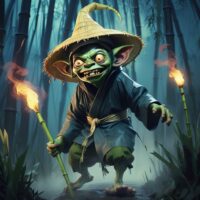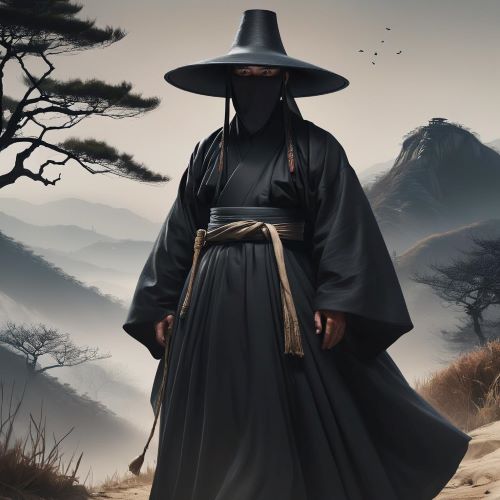Dokkakgwi : The Evil Goblin
Listen
At a glance
| Description | |
|---|---|
| Origin | Korean Mythology |
| Classification | Spirits |
| Family Members | N/A |
| Region | South Korea |
| Associated With | Evil, Strength |
Dokkakgwi
Introduction
Dokkakgwi (독각귀), often referred to as the “One-Legged Ghost” or “One-Legged Demon,” is a mysterious and fearsome figure from Korean mythology. As a subset of the more widely recognized Dokkaebi, Dokkakgwi holds a darker, more menacing presence. This creature bridges the space between malevolent spirit and supernatural trickster, often appearing in eerie tales designed to teach lessons or warn against hubris. Unlike its more playful cousin, the Dokkakgwi challenges humans physically and morally, manifesting from neglected objects or cursed spaces. With ties to both Korean and Chinese mythologies, its legend stands as a symbol of the blurred boundaries between the material and spirit worlds.
Physical Traits
What sets the Dokkakgwi apart visually is its grotesque and startling form. It has a single, muscular leg that enables it to hop at incredible speeds, giving it an unearthly, jerky movement. Its body, covered in wild, bristling hair, adds to its intimidating presence. Eyes that glow through the darkness – sometimes two, sometimes one – lend a spectral quality to its stare. The Dokkakgwi is often cloaked in a traditional straw raincoat and hides its identity beneath a wide bamboo hat pulled low over its face. It is typically seen during overcast or rainy conditions, where mist and fog help cloak its sudden appearances, creating a spectral silhouette that haunts lonely roads and mountain trails.
Family
The Dokkakgwi doesn’t have a family in the traditional mythological sense. It is not descended from gods or legendary ancestors but instead arises from spiritual transformation. Rooted in Korean animism, the belief is that objects or places saturated with strong energy – especially pain, anger, or fear – can give birth to spirits like the Dokkakgwi. These beings may originate from worn tools, weapons, or even parts of nature like haunted trees. Unlike deities with complex family trees and interpersonal dramas, the Dokkakgwi is a solitary entity. It doesn’t seek companionship but may interact with other Dokkaebi or spirits in folklore. Its isolation reflects the eerie and unnatural origins of its existence, separating it from the more communal or divine spirits in Korean myth.
Other names
Across different cultures and regions, the Dokkakgwi appears under a variety of names, each echoing its singular physical trait and spiritual function. In Korean lore, it is also called “Oedari Dokkaebi,” meaning “One-Legged Goblin,” a name that highlights its physical oddity and mythical nature. Chinese traditions include references to “Dujiaogui,” which translates to “One-Legged Ghost,” and even earlier texts like the Shanhaijing mention a similar being called “Kui,” a one-legged mountain spirit. Southern Chinese beliefs speak of the Wutong Shen, spirits with overlapping characteristics. These variations across cultures underscore a shared archetype: a supernatural creature marked by asymmetry and power, tasked with upholding moral or natural order.
Powers and Abilities
Despite its odd appearance, the Dokkakgwi is a formidable force. It is especially feared for its unmatched physical prowess, often challenging humans to wrestling matches – a favorite form being traditional Korean ssireum – where it nearly always triumphs. Its speed defies its one-legged form, allowing it to appear and vanish with ghost-like swiftness. Beyond brute strength, the Dokkakgwi may wield magical tools: the gamtu, a hat that renders it invisible, and the bangmangi, a mystical club capable of conjuring objects or making wishes come true. These items, when stolen or borrowed by humans, can shift the power dynamic between the spirit and the mortal. The Dokkakgwi is also known to manipulate the weather, especially conjuring blue supernatural flames known as Dokkaebi fire, which can light the way—or mislead unsuspecting travelers. In many tales, its power is not exercised randomly but tied to moral judgment, rewarding the humble and punishing the greedy or disrespectful.
Modern Day Influence
Though the Dokkakgwi originates from ancient myths, its influence extends into contemporary Korean culture. It appears in a number of traditional stories still passed down today, often as a warning or moral test. In folktales like The Man Who Defeated a Dokkaebi, the Dokkakgwi plays the role of antagonist who must be outwitted rather than overpowered. Modern literature has embraced the creature in fantasy retellings, often using it to explore themes of justice, deception, and transformation. In the gaming world, elements inspired by Dokkakgwi appear in titles like DokeV, where mythical beings are reimagined for new audiences, and even in international games like Rainbow Six Siege, where Korean folklore has inspired playable content.
While K-pop and Korean dramas tend to gravitate toward the more charismatic and attractive versions of Dokkaebi, elements of the Dokkakgwi can still be found in eerie dream sequences, villain arcs, and symbolic visuals. Rituals performed in rural Korean villages sometimes aim to appease mountain spirits or clear haunted paths, reflecting a continued spiritual awareness of beings like Dokkakgwi. The character also surfaces in public art, comics, and niche horror films, symbolizing a deeper cultural memory of spirits that walk the line between myth and cautionary tale.
Related Images
Source
Cho, Y. S. (2019). The Dokkaebi Phenomenon: A Look at How the Goblin Is Portrayed in K-Dramas. Asian Popular Culture Studies Journal, 18(1), 65–81.
Han, S. M. (2011). Dokkaebi in Modern Korean Literature and Cinema. Kyunghee University Press.
Lee, D. J. (2018). Reinterpreting Dokkaebi: From Korean Folklore to K-Drama. Korean Screen Studies, 6(2), 101–116.
National Folk Museum of Korea. (n.d.). Inside Dokkaebi bangmangi tale. Retrieved July 9, 2025, from https://www.nfm.go.kr
Wikipedia contributors. (2025, July 9). Dokkaebi. Wikipedia. Retrieved from https://en.wikipedia.org/wiki/Dokkaebi
Wikiwand. (n.d.). Dokkakgwi. Retrieved July 9, 2025, from https://www.wikiwand.com/en/Dokkakgwi
Mythology Worldwide. (2024, July 12). Korean Folklore: The Mysterious Dokkaebi. Retrieved July 9, 2025, from https://mythologyworldwide.com/korean-folklore-the-mysterious-dokkaebi/
World History Edu. (2023, August 10). Who are the Dokkaebi in Korean Mythology?. Retrieved July 9, 2025, from https://worldhistoryedu.com/dokkaebi-in-korean-mythology/
Frequently Asked Questions
What is lorem Ipsum?
I am text block. Click edit button to change this text. Lorem ipsum dolor sit amet, consectetur adipiscing elit. Ut elit tellus, luctus nec ullamcorper mattis, pulvinar dapibus leo.
What is lorem Ipsum?
I am text block. Click edit button to change this text. Lorem ipsum dolor sit amet, consectetur adipiscing elit. Ut elit tellus, luctus nec ullamcorper mattis, pulvinar dapibus leo.
What is lorem Ipsum?
I am text block. Click edit button to change this text. Lorem ipsum dolor sit amet, consectetur adipiscing elit. Ut elit tellus, luctus nec ullamcorper mattis, pulvinar dapibus leo.
What is lorem Ipsum?
I am text block. Click edit button to change this text. Lorem ipsum dolor sit amet, consectetur adipiscing elit. Ut elit tellus, luctus nec ullamcorper mattis, pulvinar dapibus leo.
What is lorem Ipsum?
I am text block. Click edit button to change this text. Lorem ipsum dolor sit amet, consectetur adipiscing elit. Ut elit tellus, luctus nec ullamcorper mattis, pulvinar dapibus leo.








